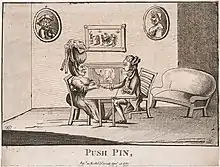Push-pin (game)
Push-pin was an English child's game played from the 16th until the 19th centuries. It is also known as "put-pin", and it is similar to Scottish games called "Hattie" and "Pop the Bonnet".[1] In philosophy it has been used as an example of a relatively worthless form of amusement.
.jpg.webp)
Rules

In push-pin each player sets one pin (needle) on a table and then tries to push his pin across his opponent's pin.[2] The game is played by two or more players.
In "Pop the Bonnet", or "hattie", players place two pins on the brim of a hat. They take turns tapping or "popping" on the sides of the hat trying to cause pins to cross one another. Whichever player causes them to cross takes the pins.[3] [4] This was a form of gambling, where a player could win or lose their pins, which were valuable as a rare imported commodity at that time.
Boys and men might stash several pins on a sleeve or lapel to be prepared to play.[5]
References in philosophy
Push-pin was immortalized by Jeremy Bentham when he wrote in The Rationale of Reward that: "Prejudice apart, the game of push-pin is of equal value with the arts and sciences of music and poetry."[6] John Stuart Mill, who disagreed with Bentham on this point, misquotes Bentham as saying, "Push-pin is as good as poetry."[7] Mill's version is now widely attributed to Bentham. The phrase comes up often in the work of R.S. Peters, a British philosopher of education, who uses some version of the phrase "why poetry is preferable to push-pin" as a way of drawing attention to the question of what is educationally worthwhile. For Peters, only intrinsically worthwhile activities warrant inclusion into the school curriculum. If a case could be made for the intrinsic educational value of push-pin (or a similar pastime), it could warrant inclusion. See for example "The Philosopher's Contribution to Educational Research," Educational Philosophy and Theory 1(2), October 1969, page 3.
Notes
- Francis Willughby's Book of Games ISBN 1-85928-460-4
- Gomme, Alice Bertha (1898). The Traditional Games of England, Scotland and Ireland : With Tunes, Singing Rhymes and Methods of Playing According to the Variants Extant and Recorded in Different Parts of the Kingdom. Vol. II (1 ed.). London: David Nutt. p. 86. Retrieved 8 June 2016 – via Internet Archive.
- Gomme, 's%20traditional%20games%20england%20push-pin&pg=PA64#v=onepage&q=%22pop%20the%20bonnet%22&f=false, p. 64
- Gomme, p.199
- ANNALS of PHILADELPHIA AND PENNSYLVANIA, VOL. II Chapter 42 FINAL APPENDIX of the YEAR 1856. NOTES and REFLECTIONS on SOCIAL CHANGES and PROGRESS IN GENERAL
- Bentham, Jeremy (1830). The Rationale of Reward (1 ed.). London: Robert Heward. p. 206. Retrieved 8 June 2016 – via Google Books.
- Mill, John Stuart (1859). "Bentham". Dissertations and Discussions, Political, Philosophical, and Historical, reprinted chiefly from Edinburgh and Westminster Review. Vol. I (1 ed.). London: John W. Parker and Son. p. 389. ISBN 9780598610782. Retrieved 8 June 2016 – via Google Books.